- About Us
- Columns
- Letters
- Cartoons
- The Udder Limits
- Archives
- Ezy Reading Archive
- 2024 Cud Archives
- 2023 Cud Archives
- 2022 Cud Archives
- 2021 Cud Archives
- 2020 Cud Archives
- 2015-2019
- 2010-2014
- 2004-2009
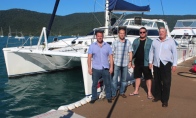 |
Sailing the Whitsundays |
For Part I of the Harris family's journey saiing The Whitsundays, click HERE.
1 Father, 3 Sons, 1 Yacht and a Lot of Wet Country:
The Harris' Sail The Whitsundays 244 Years after James Cook
August 4-12, 2014
Day 4 May’s Bay to Hamilton Island
In the way of Australian tradition, long names of people and things are shortened and short names lengthened and so Hamilton Island (not Hayman Skipper!) becomes Hamo for yachties in the know, a group to which we novices might fairly have some small claim now.
The island is a feat of careful and considered development. Ostentation has no place on the north and west of the island, though the eastern side bears the 1980’s trademarks of vanilla high rise monotony not unlike Hawaiian resorts of that era. That said, opposite Hamo is a mirror of that which it must have looked like prior to development: a scrubby, hilly and wind worn island in which only an imaginative or indigenous wisdom could find any resource or redeeming feature. Peter was taken by the efforts taken to ensure the landscaping (a mass removal and replanting exercise) was in keeping with the native schema as well as exuding the embellishments made under horticultural licence. Houses were clearly built with the Hamo hue in mind and peeked out like the narrow eyes of banksias you might miss on a cloudy day.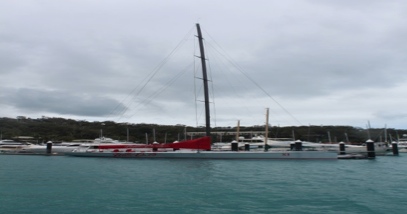
We took a bus ride as tourists to the northern most part of the island which offered a panoramic view of all that we had sailed and more. We alighted with the promise of a night off the sea in the arms of the Arms or, in this case, the Old Yacht Club, a Queenslander that for our self-perception as ‘real travellers’ was the obvious and more authentic choice than its much more lavish successor, the Yacht Club, which stood like an upturned opera House, a half peeled onion. No, on this night the Harris’ were everymen and this conviction prevailed especially in the face of a corporate junket for a loans company sponsored by the Commonwealth Bank and sparing no expense. The pub proletariat which included us in its membership also included a family from Windsor and a gaggle of 40 year-olds ladies from Wollongong, with whom we had an easy patter. Stu, as usual, was mistaken for a ‘sexy actor’, but this time a balding Englishman called Jason somebody. While Stu was mobbed, Pete crashed the corporate do with members of both our allied parties also penetrating the defences, a kind of fun tongue in cheek protest against the Tragedy of the Commons as the corporation took over the public space. I debated with an officious kiwi who claimed we and our friends would be booted out of the public bar on account of the after party and I put the fear of God into her by introducing myself as Chris Oatley and showing her ‘my family’s’ name ensigned like a coat of arms on every bottle and on the wine list and pointing to Wild Oats, ‘my runabout’ and issuing a stern warning to her to treat ‘all the guests on my island with respect’. Dad had rum and coke in a tall glass and enjoyed the band that played despite the mock war of the worlds taking place around him. A good night had by all except the security.
Day 5: Hamo to Whitehaven Beach (9/8/14)
Aches assailed heads but no headsails ached on the brisk and bounce-less journey to what must be one of the most beautiful beaches in a country with many. We put up headsails in no time and with little resistance, all the while wondering at our previous incompetence in the way of all on the getting of wisdom. We had a chap called Tony to thank who fortuitously moored behind us on Hamo with what could have been the entire cast of Don’ Party, and who also happened to be the Tony of the Tony and John Managerial team at Whitsunday rent a Yacht. In responding to our pleas for help in relation to why the boat constantly steered back to the wind used the analogy of an arrow. “The purpose of the feathers on an arrow is to swing the arrow straight into the wind and this is the effect the mainsail is having, which is why I often sail with only Headsail on these cats.” We got a nice run with the wind behind us as we headed to the Molles and then gibed back through the Hook Island Channel (with Whitsunday Island) to the North-East. We downed sails in this small passage and putt putted passed the now defunct Hook Island Resort on whose mooring we had been rudely waved off the prior day in our vain attempt to stop in order to do some current diving in the coral fringes opposite. We smiled the smirk of revenge in the general direction of the caretaker who had dismissed us, a smile that directed blame for the resort’s redundancy on his lack of hospitality, perhaps an accusatory bridge too far.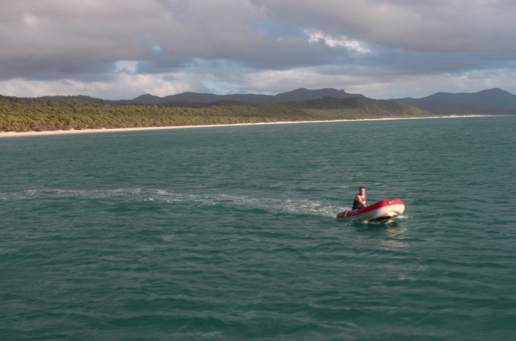
The turn south to travel along the East side of Whitsunday lulled us into a false feeling of security in which we hoisted the main before a cranky sky reminded us of the hubris in predicting weather, The dark grey hostility was the Skipper’s chagrin and he proved braver than the crew as we advised against using sails into the wind and tide in the changing conditions. He opted for safety over sails and while, in hindsight, I think the trip could have been made, other yachts arriving the next day after a treacherous night at North Whitehaven would reinforce the wisdom of our decision as the only one that could have got us there in time.
Helming in that storm was like being shot into a water cannon whose discharge had passed through a salt mine. Yet what is a reward earned without suffering, because to gaze upon Whitehaven Beach, even in tumultuous weather is to gaze upon Eden itself for us of a coastal heritage. Beyond the chalk of that perfect sand loomed the tops of masts to confuse the weary sailors’ eyes and whose presence is still unresolved by the author although we expect they were vessels deeply entrenched in Tongue Bay to the west of the beach.
On and on for 7 land kilometres shines the white fringe of Whitehaven as if calmed by God Himself. Despite now howling winds and a grey ceiling, Stu and I jumped in and almost desperately swam to the snowy looking shore. Meanwhile, Pete watched in case of mishap and primed the gas oven for Lasagne and his ‘special’ Garlic Bread. Skipper earned a deserved break from his insubordinate brood and had a requisite Granddad Skipper nap. He no doubt dreamed the dreams of Burke and Wills: of salty lakes, unforgiving climates and scurrilous subordinates.
“The Germans are closing in.” Not a cry from the trenches but from the aft benches as Skipper extinguished his cigarette and manned the helm. Catnap had dragged some 30 or so metres on its anchor chain and we were now running close to a German mono-hull that had been a decent 60 or so metres up beach from us when we first dropped anchor. We could not say he started it this time, for he had both stern and bow anchors. The fault lay with us and we hurriedly forsook the position for what turned out to be an even better spot close to the beach. That night was rather rocky as was cautioned in all the guides and there were rotating shifts of night-watchmen from all 4 berths gingerly stumbling from slumber to ensure an adequate distance from boats of all ethnicities, headlands and other incongruous imaginings surviving from the hurriedly disturbed unconscious, thereby confirming all was right. The morning light on Paradise made forgiveness for poor moorings.
Day 6: Whitehaven Beach to Cid Harbour 10/8/ 14
No breakfast was the order to ensure we got a head start on the wind for best conditions at Chalkies beach for diving. With a South-Easterly turning East we had the pick of conditions for sailing and went about out routine calisthenics. SO successful were we that we sailed right passed Chalkies (Haselwood Island) but rather than retreat around Honeymoon Island we accepted we would not be consummating our diving passion then and we sailed on ceaselessly with the tide. Sails full and skies a light over cast we easily forgot the navigational oversight (the only one of the journey as it proved to be) and put all energies into sailing in a solid 15-20 knot wind on almost a run towards Border Island to the North. We steered a 120 degree line (Stu said I was obtuse, but it was much too early for geometrical humour). This angle was always the best result as the cat did not like to sail too close to the wind much to the Skipper’s disappointment as he had had some great experiences on mono-hulls. We moved at such a nice rate of knots now for the Skipper to remark: “We could ski behind her”, a yachtie rule of thumb that suggests a speed upwards of 10 knots. We gibed flawlessly back to the south west and had an equally smooth run with tide, swell and sail in harmony. As the hitherto elusive sun now thrust downstage amid the retreating chorus of cumulus, the white keys of Whitehaven chimed a stunning farewell encore.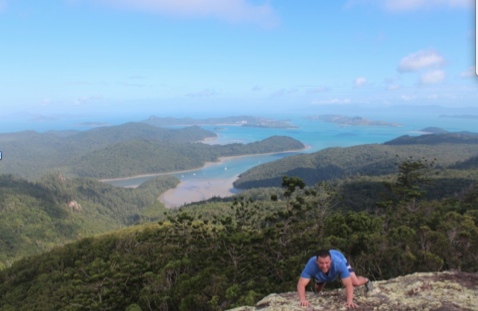
Our journey back along the same path that had pelted us with slings of salt and arrows of aqua angst the previous day was now a turquoise and sky-blue melody spotted with speckles of sunlight. The protruding tip of tongue bay licked the stern goodbye like a friendly dog and we continued south of the dive boats of Dumbbell Island back to the well traversed sanctity of Hook Passage against the outgoing tide. At 12:30pm, Cid Harbour was already popular for boats and for good reason. Anchoring into a southerly that was all but fended off by the highest peak of Whitsunday Island and the Island Group for that matter, Cid harboured many attractions for the bushwalking enthusiasts and was claimed to have a dive spot of some note. Stu and I appropriated Pete’s Punt and putted to Sawmill Beach, so called for its previous life as the shore on and through which hardwood had once been harvested. The path up to Whitsunday Peak (435m) was a fairly easy walk for Chris which meant by comparison that Stu barely even troubled his heart passed a resting rate. The Guidebook advised that the path might be a 4 hour round journey of 2.5 kilometres but we went at a brisk pace up and it was done in 45 minutes. Downhill was even faster as gravity always wins. The flora was not particularly exotic for an Australian familiar with the bush, and neither was the fauna which either avoided tourists or was nocturnal. In fact, we were not at all met with any creatures be they human or otherwise. The peaks are a granite rock face south and north facing and photos will display one sweaty explorer looking a little wobbly on sea legs and another similarly gingery but only having raised a dry glow. The view is spectacular across all the islands.
Ross Islet: The Ghetto for Ugly Coral
If the ocean and the brain are indeed our last frontier then diving at Ross Islet might be a peephole into both. This small cousin to Cid Island’s East lies a 300 metre putt by tender but a journey far further into the imagination. The diver may find himself in an extra-terrestrial atmosphere, a long way from anywhere. In its defence, we did approach Ross islet at the worst time: with a fast moving in-coming tide, when the sun was hidden behind Cid Island and eddies abounded, whirlpooling all who encountered them across the periphery of the dive space. Like some highly evolved penguin Stu hopped across the Martian landscape of the temporary and now rapidly depleting island to place the anchor of Pete’s Punt behind two moon rocks. The current shot down the western side of the rocks and in that we started our prognosis of the shadowy side of the ocean brain by heading up into the artery of water now pummelling us. The divers’ first sighting is of what we believe to be coral that, in Stu’s perception, resembled a spilt milkshake of ill-defined flavour, neither chalky like bleached vanilla coral nor iridescent and strawberry flavoured like the more lively coral at Luncheon Bay. 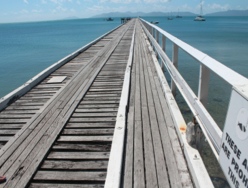
The diver is then met by a cloud of silt like underwater dust that ensures three brothers’ heads will bob in frantic search of each other. Pete lamented through a sand-sooty snorkel that ‘this must be where the ugly coral is sent’, a humorous observation indeed. Indeed this was community of dead and dying shape shifting abscesses that will never adorn the front side of a postcard or appear in the seminal “1000 Magic Miles” Bible for mariners. The lack of key lighting in the shadow of Cid did not advance their case to the powers that be at coral casting!
Depth perception was difficult to control in such light. Especially concerning with a sheer cliff only 5 metres off the Islet and many encounters with our fearless three ensued as they flippered urgently back towards the shore caught by surprise by the pull of the cliff. My crotch had one such encounter with a gooey coral miscreant while I was hastily beating a return from the abyss on the other side of the cliff. I leapt to my feet in what I had thought was 1.5 metres of water at least to discover embarrassingly that it barely covered my shin. Even through foggy and slimy masks we could read each other’s shared conviction that this was the time to abort this chance meeting with the seamier side of Whitsunday Tourism.
Day 7: Cid Island to Shute Harbour HQ via South Molle
In the way of all things and holidays, the last day of the odyssey awoke under a blanket of blue sky, unfettered sunshine and calm 10-15 knot winds. Murphy’s Law had once again decided the case and hardened novices in the shape of the Harris 4 were ironically frustrated by the ease with which both sails went up and the slow and controlled progress of Catnap, the very same conditions we’d fantasised about as we leapt like fools on the high seas of the first days of the journey. What an unreliable repository for memories of pain the human psyche is.
In some ways the slow sail was a blessing because South Molle would prove to be our Bermuda Triangle in that we were unable to get closer or move further way. It wasn’t until we aborted plans with the slow progress to sail around North Molle that a miraculous passage of wind and current beckoned the bow into South Molle.
Our selection of anchorages had consistently improved night by night over the 7 days with good selections made by skipper and this would be the Shangri La. For the Skipper South Molle was a homecoming of sorts, his excitement manifested in the taking of the closest mooring to the jetty and the beach, a triumphant shirking of the heavy burden of responsibility that had been his lot as Captain, our Captain. With Stuart and me, the Skipper punted over to the resort we had heard was now retired and the Skipper was filled with trepidation as to what we might find as he had a halcyon view from a pre-Vietnam trip he had made with a fellow Digger, drinking and diving their way around the island almost 50 years prior. We were greeted by a foreign gardener who seemed to be winning the battle with nature as he went about grooming the well-manicured grounds. This was the first clue that all was not lost. A European Amazonian creature on an Apple Mac laptop was the second and the rather appealing manager the third. We paid the customary courtesy for pinching a mooring and she gave us a potted history for the last 6 years: moving markets; dollar dilemmas and investor insecurities. The owner/s were now waiting and seeing, chiefly using the resort for 2 day stopovers as one leg on a backpacker package. I should think this means a steady cash flow and some control of variable costs in a volatile market not kind to such intangibles. As you may detect, Skipper and I had resort dreams sparkling in our ex-hotelier eyes.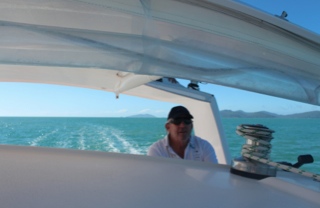
The gay abandon with which we took the inner mooring did not escape omniscient nature’s eye and the alarm sounding as we settled on our post lunch ‘brew’ signified that the out-going tide was pulling the keel closer and closer to the floor and we sadly abandoned our diving and bushwalking plans.
One last sail with a gibe and 2 tacs and the South Molle Plug Hoe sucked us in until we succumbed, downing tools and sails for the final time, meandering carefree back to Shute Harbour, odyssey complete with one Volvo Penta motor on the blink but 2 sails and four temperaments in check and one amazing Skipper on the eve of a 70th birthday still sailing the wide blue yonder.
Late that night at a salubrious saloon peeking over Airlie beach the Skipper celebrated 70 with a rum and coke, his 3 sons and a large slice of tiramisu. He waited some time for the candle to stop rocking, made a wish no doubt about the next adventure, then blew it out first go, grinning the grin of a man who had sailed the oceans again and brought home his sons safe and as sailors. Well, sort of...
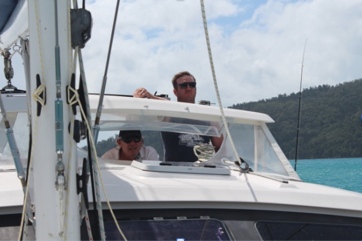
Borne back ceaselessly against the tide. That, and a lot of shits and giggles!
When not embellishing traveller’s tales, Christopher W. Harris is a permanent travelling expat in Singapore where he is Head of School, Kaplan. He resides there with his teacher wife, Sarah, daughter, Grace (40 stamps on her 5 year old passport) and son, Angus “Chook” Harris, born in Malaysia (30 on his 3 year old passport ) and reading The Cud is his link to home. Hailing from Sydney’s northern beaches and later the Far North Coast of NSW and Gold Coast, Chris and his brothers were more used to being in the water than on it through surf life saving, swimming and surfing, and had merely dabbled in sailing only. Their father, Wal, and the protagonist-skipper of our story, had, however, fallen in love with it when taken on leave by a well to do Boarder friend at school in the late 1950’s to sail the Sydney Harbour.
